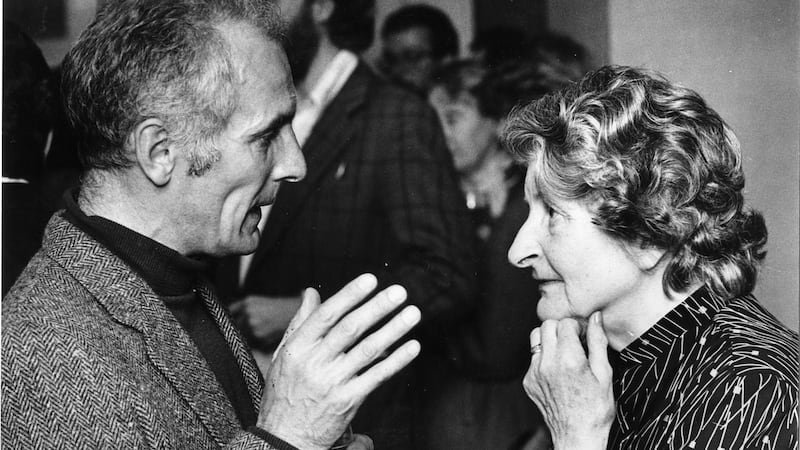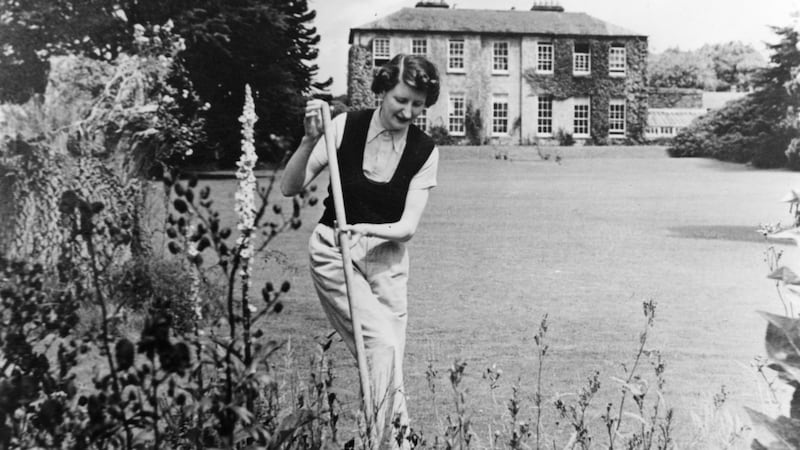In 1945 Elizabeth Bowen wrote to her lover Charles Ritchie that "The people I was staying with – Bobby and Molly Keane – have the most heavenly child called Sally; you would have loved her: I did".
With a coastal breeze blowing through her still-auburn hair, Sally Keane Phipps smiles at the description of herself as heavenly. We meet at her cottage near Cloyne in Co Cork: she has just returned from London. Her book Molly Keane: A Life, which will be published by Virago in January, tells the story of the playwright and novelist who wrote under her own name and, earlier, as MJ Farrell.
Topography weaves a network of friendships throughout east Cork and west Waterford in these headlands between the Blackwater river and the ocean. Claude and Patricia Cockburn and their three sons lived in Youghal before moving to Ardmore, the seaside village where Dysert was Molly Keane's home for more than 40 years and where she died in 1996.


One of Molly's confidantes was Adele Astaire, wife of Charlie Cavendish, sister of Fred and chatelaine of Lismore Castle. When Phipps mentions Angie Shaw down the road, she's talking about Angela Lansbury. The sculptor Ken Thompson and his wife, the painter Rachel Thompson, live nearby in Ballycotton.
For the widowed Molly Keane and her daughters, Sally and Virginia, the modest house on the cliff above Ardmore Bay was both retreat and refuge. After Bobby Keane’s sudden death in London in 1946, they left Belleville, their country house near Cappoquin, and moved restlessly from rental to rental until they reached Dysert.
Later, Keane was to write of those days: “The loss was greatest for my elder child – six years.” Both her worlds were gone: her father whom she adored, and Nanny, whom she trusted.
Elizabeth Bowen and Molly Keane remained lifelong friends. Again in her letters, Bowen mentions visiting Ardmore after “my dear Sally’s first grown-up ball” with her younger sister, Virginia, bored and furious at being left out if it. Now, in Phipps’s story of her mother’s life, Bowen shines within a constellation of friendships piercing the sky above the collapsing universe of the Irish gentry.
“The Anglo-Irish world is almost gone now, and that’s good,” says Phipps. “It was limiting to the human spirit, I think. But it’s history.”
For Phipps, that history is of an Ireland from which, for years, she was determined to shake herself loose.
“My experience of the Anglo-Irish was a much freer one than Mum’s, and although in a way I was a softer character than she was, I was also very obstinate, especially when I was young, deliberately espousing views that I knew would annoy her,” she says. “In a way, that was a good thing, but in another way it was also unfair to the people in our background, often magnificent people.”
Interrupting
The difficulty in interviewing Sally Phipps on the eve of the publication of Molly Keane: A Life is to resist the temptation to interrupt the flow of stories. There's the girls' schooling, graduating from governesses to a convent in Dorset (the young Phipps comforted by the gift of a Jaeger coat) or boarding in Dublin and London. There's Phipps's further education in France, on which her long attachment to that country is founded.
There's Binkie Beaumont and Phipps's godfather, Sir John Gielgud, and Margaret Rutherford and Sybil Thorndike in London's green rooms during Keane's career as a playwright in the 1930s and 1940s.
That period included the immense success of Spring Meeting, the American run of which subsidised Molly and Bobby Keane's honeymoon in 1939. Bride and groom travelled on a liner from Cobh, joining some European passengers who Keane said looked as if they were fleeing before a dragon.
There’s the 1921 burning of Ballyrankin, Keane’s family home, when the arsonists put armchairs on the lawn so her parents could watch the destruction in comfort. Instead, they leaned against the haycocks and then walked, in their nightclothes, to Bunclody. Keane’s mother said that as beautiful 18th-century houses were set ablaze across the country, the air smelled of clover and smoke.
There's Woodruff, the house to which Keane exiled herself in search of the "fun" denied her at Ballyrankin. Woodruff was home to her eventual theatrical collaborator John Perry and also to the butler who whispered betting tips as he served the dinner guests.
There’s the hunting, which is “under such a cloud now that it’s very difficult to describe Molly’s generation’s passion for it. For them, it was the heart of life.” Phipps believes that the spaces between the two worlds of those galloping ranks and the people of the household, the stables and the farms were where real life happened for the Anglo-Irish child.
“It was only when I grew up and became more politicised that I realised that the Anglo-Irish life wronged the people of Ireland,” she says. “Their empathy with the landscape made the Anglo-Irish feel they were a part of it. In my view, the Ireland they chose to ignore, the country untainted by anything English, which was nurtured in people’s hearts and carried in code through music and poetry, that Ireland was always there. They just didn’t see it.’
There's the background: Keane's father, Walter Skrine, had been a rancher in Canada before retiring to indulge his obsession with horses and hunting. Her mother, notably indifferent to the young Molly, was a poet whose collection Songs of the Glens of Antrim outsold WBYeats.
There's the death of Bobby Keane in 1946, which happened so suddenly that Keane, shocked with grief and with a new baby, could not attend his funeral in London. Even years later, when her daughter Virginia discovered where her father was buried, Keane refused to visit his grave. "She looked completely stricken. She said she wanted to remember Bobby alive, not in his grave. She said of course she wouldn't go there."
Later, Keane asked Norah McGuinness and Bobby’s brother Walter Skrine to mark the grave in London with a Celtic cross.
Mac Liammóir makes paella
Phipps was present for much of what she has written in this biography. She was there when Micheál Mac Liammóir made paella in the Ardmore kitchen. She remembers that when Charlie Cavendish, too ill to get out of his chauffeur-driven car, paid his last visit to Belleville, her parents sat in the car to talk to him. Phipps was so excited at the little fold-out seat she was given that the pathos of their meeting escaped her. Cavendish died later that evening. She remembers her small self astounded by the vast ballroom at Dromana House before the Georgian section of the house was demolished.
“Many of the things I’ve written about are not really researched,” she says. “They’re just around you, and when you think about it they come back. I was particularly fascinated by Molly’s childhood, and she was so good at talking about it.”
They were not myths, these stories and their details, such as the hunting mornings when the hall tables of the grander houses offered bunches of violets to be tied into buttonholes with a shred of flax. No myth either in the story that horrified and haunted Molly: the discovery of a dead baby floating down the river Slaney in a Switzers dress box addressed to Miss Molly Skrine. "She told that story again and again."
When Phipps married the widowed George Phipps in 1972, his three children became her close family. Together they farmed at Kilcor, near Castlelyons in Co Cork, until George retired and they moved to Cloyne. By then, Keane's novel Good Behaviour had been rescued from a drawer in Ardmore and published by Deutsch. At least 10 novels appeared in the 1930s and 1940s under the pseudonym MJFarrell, but it was the theatre that made Keane famous, before her writing life foundered with the failure of several productions, out of tune with the times, compounded by Bobby's death.
"She said writing was such agony she was glad not to have to do it any more," Phipps says. "She concentrated on domesticity, at which she was so good and so rooted. But she wrote a book just for herself; we didn't know anything about Good Behaviour until it was accepted by a publisher. It's a very fierce book. I think she was a little afraid of it because although she was wonderfully astute about human nature, she also loved to give people a good time. People were so important in her life; she said they were like the potter's clay to her hand."
Fierce books
More fierce books followed, but Molly Keane did not want to write her autobiography and it was agreed that Phipps, who had already worked with her mother on the anthology Molly Keane's Ireland (1994), would take on the task.
“She wouldn’t have approved of its taking so long,” Phipps says. “That’s partly my nature: I can’t keep too many balls in the air at the same time.”
Chief among other troubles during those years was George’s death in 2013.
Her long engagement in her mother’s life has emphasised for Phipps something of her own literary qualities.
"I should always have been writing," she says. "Mum always felt I should write, she thought it was my only talent. I didn't agree. I wanted to do other things. But I went to a seminar given by Jennifer Johnston at Listowel Writers' Week one year and submitted a little exercise. She said: 'Sally, you are a writer, get on with it.' But of course I didn't."
Sympathetic but not sentimental, Phipps came to understand Keane’s comment on how hard it was to write about life, and then to actually live it.
“What I hope I have managed to do is to show what her life was, the complications of her nature, what she had overcome and what she had enjoyed,” Phipps says. “She said her life was all in the novels, and although I can recognise the books that matter, fiction is an unstable resource really. One wants to be truthful; truth is so much more interesting.”
Gradually, as anecdote, detail and recollection merged, her mother became, for Phipps, a different woman.
“We had very different temperaments,” she says. “It’s not that I grew to like her more; it’s that I think I understood her better. She had all sorts of opinions, but she lived in quite a different way from her opinions because she had such an interest in humanity. But her panache when she was angry was very hard to withstand: even for her, the clash of her total compassion and then her great harshness was difficult to live with. Yet I never doubted that she loved me.”
Even Elizabeth Bowen, writing in 1957, found that conflict dismaying: “Molly Keane is as clever as a bag of monkeys. But her cynicism and pessimism are terrifying.”
No wonder, perhaps, that in her notebooks Molly Keane kept a diary of her own decline.
“It’s true that in her later novels Molly was writing out of her own colour, her own bleakness, but she was also writing against the swell of forgetfulness,” Phipps says. “At the end she found the splendour of life very hard to let go. When she knew it was fading, she wasn’t reconciled.”
Who could be, I wonder, as I leave the cottage edged by the glittering sea and the harvested fields, which seem to throb still to the crunch of a winter hunt. A hawk balances unperturbed on a five-bar gate, scanning the stubble. This is a scintillating autumn day, the landscape striped green and gold in the wash of sea and sunlight, brilliant with the splendour of the life Molly Keane cherished and Sally Phipps describes.
Dysert is now run by Virginia Keane Brownlow as a venue for writing residencies, seminars and literary events; mollykeanewritersretreats.com. Molly Keane: A Life will be published by Little Brown on January 26th











